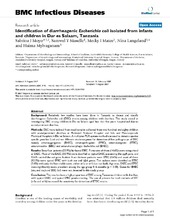| dc.contributor.author | Moyo, Sabrina John | en_US |
| dc.contributor.author | Maselle, Samwel Y. | en_US |
| dc.contributor.author | Matee, Mecky I. | en_US |
| dc.contributor.author | Langeland, Nina | en_US |
| dc.contributor.author | Mylvaganam, Haima | en_US |
| dc.date.accessioned | 2014-12-12T09:21:59Z | |
| dc.date.available | 2014-12-12T09:21:59Z | |
| dc.date.issued | 2007-08-09 | eng |
| dc.identifier.issn | 1471-2334 | |
| dc.identifier.uri | https://hdl.handle.net/1956/8920 | |
| dc.description.abstract | Background: Relatively few studies have been done in Tanzania to detect and classify diarrheagenic Escherichia coli (DEC) strains among children with diarrhea. This study aimed at investigating DEC among children in Dar es Salaam aged less than five years hospitalized due to acute/persistent diarrhea. Methods: DEC were isolated from stool samples collected from two hundred and eighty children with acute/persistent diarrhea at Muhimbili National Hospital and Ilala and Mwananyamala Municipal Hospitals in Dar es Salaam. A multiplex PCR system method was used to detect a species specific gene for E.coli and ten different virulence genes for detection of five pathogroups of DEC namely enteroaggregative- (EAEC), enteropathogenic- (EPEC), enterotoxigenic- (ETEC), enteroinvasive- (EIEC) and enterohemorghagic- Escherichia coli (EHEC). Results: Sixty-four patients (22.9%) harbored DEC. Forty-one of them (14.6%) were categorized as EAEC. Most of the EAEC (82.9%) were classified as typical EAEC possessing the aggR gene, and 92.6% carried the aat gene. Isolates from thirteen patients were EPEC (4.6%) and most of these (92.3%) were typical EPEC with both eae and bfpA genes. Ten isolates were identified as ETEC (3.6%) with only the heat stable toxin; either st1a or st1b but not both. Age wise, EAEC and EPEC were significantly more prevalent among the age group 0–6 months (p < 0.05). Genes for EHEC (stx1 and stx2) and EIEC (ial) were not detected in this study group. Conclusion: The results show a high proportion of DEC among Tanzanian children with diarrhea, with typical EAEC and typical EPEC predominating. The use of primers for both variants of ST1 (st1a and st1b) increased the sensitivity for detection of ETEC strains. | en_US |
| dc.language.iso | eng | eng |
| dc.publisher | BioMed Central | eng |
| dc.rights | Attribution CC BY | eng |
| dc.rights.uri | http://creativecommons.org/licenses/by/2.0 | eng |
| dc.title | Identification of diarrheagenic Escherichia coli isolated from infants and children in Dar es Salaam, Tanzania | en_US |
| dc.type | Peer reviewed | |
| dc.type | Journal article | |
| dc.date.updated | 2013-08-28T17:08:51Z | |
| dc.description.version | publishedVersion | en_US |
| dc.rights.holder | Copyright 2007 Moyo et al; licensee BioMed Central Ltd. | |
| dc.rights.holder | Sabrina J Moyo et al.; licensee BioMed Central Ltd. | |
| dc.source.articlenumber | 92 | |
| dc.identifier.doi | https://doi.org/10.1186/1471-2334-7-92 | |
| dc.identifier.cristin | 366715 | |
| dc.source.journal | BMC Infectious Diseases | |
| dc.source.40 | 7 | |

